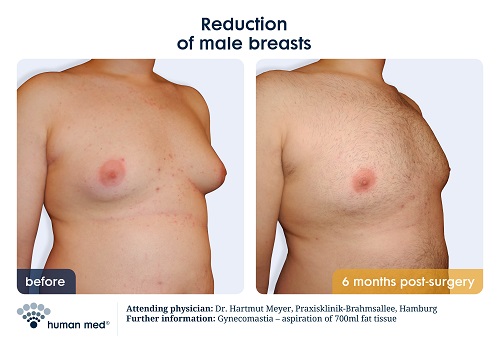Anyone considering surgery should approach the decision with a healthy amount of respect and caution especially when the surgery is elective (or planned) and is non-essential surgery (as aesthetic or cosmetic surgery generally is). All surgical procedures have limitations in terms of what is an achievable outcome and it is important that your expectations match what is possible through surgery. The choice to go ahead with surgery is always (or should always be) taken after due consideration of the risk-benefit balance for the procedure. Although the majority of patients do not experience problems it is important that you fully understand all the potential risks and complications of Gynaecomastia surgery. It is important that you take the time to read over them again prior to your next consultation.

Healing Issues
Certain medical conditions, dietary supplements and medications may delay and interfere with healing. Patients with massive weight loss may have a healing delay that could result in the incisions coming apart, infection, and tissue changes resulting in the need for additional medical care, surgery, and prolonged hospitalisations.
Patients with diabetes or those taking medications such as steroids on an extended basis may have prolonged healing issues. Smoking will cause a delay in the healing process, often resulting in the need for additional surgery. There are general risks associated with healing such as swelling, bleeding, and the length of surgery and anesthesia that include a longer recovery and the possibility of additional surgery, prolonged recovery, color changes, shape changes, infection, not meeting goals and expectations, and added expense to the patient.
Patients with significant skin laxity will continue to have the same lax skin after surgery. The quality or elasticity of skin will not change and recurrence of skin looseness will occur at some time in the future, quicker for some than others. There are nerve endings that may become involved with healing scars during surgery. While there may not be a major nerve injury, the small nerve endings during the healing period may become too active producing a painful or oversensitive area due to the small sensory nerve involved with scar tissue. Often massage and early non-surgical intervention resolves this. It is important to discuss post-surgical pain with your surgeon.
Bleeding
It is possible, though unusual, to experience a bleeding episode during or after surgery. Should postoperative bleeding occur, it may require emergency treatment to drain accumulated blood or you may require a blood transfusion, though such occurrences are rare. Increased activity too soon after surgery can lead to increased chance of bleeding and additional surgery. It is important to follow postoperative instructions and limit exercise and strenuous activity for the instructed time. Do not take any aspirin or anti-inflammatory medications for at least ten days before or after surgery, as this may increase the risk of bleeding. Non-prescription “herbs” and dietary supplements can increase the risk of surgical bleeding.
Hematoma can occur at any time, usually in the first three weeks following injury to the operative area. If blood transfusions are necessary to treat blood loss, there is the risk of blood-related infections such as hepatitis and HIV (AIDS). Heparin medications that are used to prevent blood clots in veins can produce bleeding and decreased blood platelets.
For Gynaecomastia surgery it is important to limit the movement of the pectoralis muscle post operatively, which means restricting the use of shoulder movement as much as possible for the first 2 weeks following surgery. Simple steps to minimise stretching the pectoralis muscle include trying to limit lifting the arms above shoulder level and avoiding lifting any heavy objects.
Infection
Subacute or chronic infections may be difficult to diagnose. Should an infection occur, treatment including antibiotics, or additional surgery may be necessary. Individuals with an active infection in their body or should not undergo surgery. Although infection is unusual after this type of surgery, it may appear in the immediate post-operative period or at any time after surgery. It is important to tell the hospital or Mr. MacQuillan’s practice of any concerns if you feel that your wounds or site of surgery may becoming infected or of any other infections, such as ingrown toenail, insect bite, or urinary tract infection. Remote infections, infections in other parts of the body, may lead to an infection in the operated area.
Scarring
All surgery leaves scars, some more visible than others. Although good wound healing after a Gynaecomastia surgery is expected, abnormal scars may occur within the skin and deeper tissues. Scars may be of different color than the surrounding skin tone. Scar appearance may also vary within the same scar. Scars may be asymmetrical (appear different on the right and left side of the body). Scars can appear thick, red and raised all or part of the way along the incision line (a hypertrophic scar) or more rarely can involve tissues beyond the incision itself (and can resemble a badly healed burn), this is known as a keloid scar. Additionally, scars can tether to underlying structures or become abnormally pigmented. It is possible that additional treatments may be required for adverse scarring. There is the possibility of visible marks in the skin from sutures. In some cases scars may require surgical revision or treatment.
Firmness
Excessive firmness can occur after surgery due to internal scarring. The occurrence of this is not predictable. Additional treatment including surgery may be necessary.
Skin Discoloration / Swelling
Some bruising and swelling normally occur. The skin in or near the surgical site can appear either lighter or darker than surrounding skin. Although uncommon, swelling and skin discoloration may persist for long periods of time and, in rare situations, may be permanent.
Skin Sensitivity
Itching, tenderness, or exaggerated responses to hot or cold temperatures may occur after surgery. Usually this resolves during healing, but in rare situations it may be chronic.
Major Wound Separation
Wounds may separate after surgery. Should this occur, additional treatment including surgery may be necessary.
Sutures
Most operations involve the routine use of deeply placed sutures (stiches) within and beneath the skin. Such sutures are usually designed to be dissolving however in some individuals they make take longer to dissolve than intended or may provoke a reaction from the body. In such instances they may form small pockets of inflammation (stitch granulomas or abscesses) which resemble an infection but are in fact due to the underlying stitch. Similarly, the stitch may poke through the skin and become uncomfortable. In such cases the stitches will require removal.
Delayed Healing
Wound disruption or delayed wound healing is possible. Some areas of the skin may not heal normally and may take a long time to heal, some areas of skin may even die. This may require frequent dressing changes or further surgery to remove the non-healed tissue.
Individuals who have decreased blood supply to tissue from past surgery or radiation therapy may be at increased risk for delayed wound healing and poor surgical outcome. Smokers have a greater risk of skin loss and wound healing complications.
Surgical Anesthesia
Both local and general anesthesia involve risk. There is the possibility of complications, injury, and even death from all forms of surgical anesthesia or sedation.
Shock
In rare circumstances, your surgical procedure can cause severe trauma, particularly when multiple or extensive procedures are performed. Although serious complications are infrequent, infections or excessive fluid loss can lead to severe illness and even death. If surgical shock occurs, hospitalisation and additional treatment would be necessary.
Pain
You will experience pain after your surgery. Pain of varying intensity and duration may occur and persist after breast scars. Chronic pain (neuropathic pain) may occur very infrequently from nerves becoming trapped in scar tissue or due to tissue stretching.
Cardiac and Pulmonary Complications
Pulmonary complications may occur secondarily to both blood clots (pulmonary emboli), fat deposits (fat emboli) or partial collapse of the lungs after general anesthesia. Pulmonary emboli can be life-threatening and even fatal in some circumstances. Inactivity and other conditions may increase the incidence of blood clots traveling to the lungs causing a major blood clot that may result in death.
It is important to discuss with your physician any past history of swelling in your legs or blood clots that may contribute to this condition. Cardiac complications are a risk with any surgery and anesthesia, even in patients without symptoms. If you experience shortness of breath, chest pain, or unusual heart beats, seek medical attention immediately. Should any of these complications occur, you may require hospitalization and additional treatment.
Allergic Reactions
In rare cases, local allergies to tape, suture material and glues, blood products, topical preparations or injected agents have been reported. Serious systemic reactions including shock (anaphylaxis) may occur in response to drugs used during surgery and prescription medicines. Allergic reactions may require additional treatment.
Specific Risks of Gynaecomastia Surgery
Change in Nipple and Skin Sensation
You may experience a diminished (or loss) of sensitivity of the nipples and the skin of your breast. After several months, most patients have normal sensation. Partial or permanent loss of nipple and skin sensation may occur occasionally. Changes in sensation may affect sexual response. In rare circumstances the nipple may be lost entirely.
Nipple Asymmetry
The shape, size and position of the nipple on the breast may differ following surgery. Although every effort is made to ensure symmetry differential healing between the breasts and scar formation will have an impact on the appearance of the nipples on each side.
Nipple Necrosis
Nipples may need to be re-sited during Gynaecomastia surgery (especially with very large volumes of breast tissue). If there is any problem with the blood supply to the nipple (possibly because the nipples have had to be moved a long way), this may affect the healing and even the survival of the nipples.
In the worst-case scenario (which is fortunately very rare) the entire nipple may die. Otherwise, part of the nipple may form a scab, which will eventually heal underneath. If you are unlucky enough for this to happen, you may require revision surgery in the future to address poor scarring or to reconstruct a new nipple for you.
Nipple Tethering
As part of the process of removing excess breast tissue from underneath the region of the nipple there will be subsequent scar formation. It is possible that such scar formation can fix the nipple to the underlying muscle and cause it to appear tethered to the chest wall or retracted. This may be visible either at rest or when the muscles are contracting. Such a problem may require additional corrective surgery.
Skin Contour Irregularities
Contour and shape irregularities may occur. Visible and palpable wrinkling of skin may occur following Liposuction associated with Gynaecomastia surgery (corrugation) and it is possible to get dishing of the soft tissues or a depression within the area from where the Gynaecomastia tissue is treated. Residual skin irregularities at the ends of the incisions or “dog ears” are always a possibility when there is excessive redundant skin. This may improve with time, or it can be surgically corrected.
Damage to Deeper Structures
There is the potential for injury to deeper structures including nerves, blood vessels, muscles, and lungs (pneumothorax) during any surgical procedure. A pneumothorax (puncture of the lung may require a tube to be inserted into the chest in order to re-inflate the lung). The potential for this to occur varies according to the type of procedure being performed. Injury to deeper structures may be temporary or permanent.
Fat Necrosis
Fat cells in the subcutaneous tissue (under the skin) have a relatively poor blood supply and are quite susceptible to traumatic damage. With the effects of surgery, it is possible for some of the fatty tissue to die and form scar tissue (which can be felt a lumpiness beneath the skin). If there are large areas of fatty tissue that suffer from necrosis this may require removal or can result in prolonged discharge from the incision. If an area of fat necrosis became infected this would cause and abscess, which would require surgical drainage. It is possible that skin contour abnormalities can be caused by fat necrosis.
Seroma
A seroma can be best thought of a collection of fluid beneath the skin at a surgical site. The composition of a seroma is much the same as that of blood but without the actual blood cells (it contains similar proteins and salts to blood) and is usually the result of lymphatic fluid accumulation (this is the 10% of the fluid that escapes from capillaries within tissues but does not return back to the veins via the small blood vessels but rather by the lymphatic drainage vessels) or by direct production from inflamed tissue. If this occurs there is the possibility it will need to be drained (often by simple aspiration with a needle or syringe, though in rarely can require a further operation to remove completely). If a seroma were to become infected it may require further treatment with antibiotics or surgical drainage.
Asymmetry
Asymmetry naturally occurs in most people, and the size of the underlying pectoralis muscle differs between the dominant and non-dominant arm and this too will have an impact on the appearance of the chest both before and after Gynaecomastia surgery. Differences in terms of breast and nipple shape, size, or symmetry that are present before surgery will persist post-surgery and surgery itself can cause asymmetry of the breast and nipple.
Tips for preparing for Gynecomastia Surgery
Preparing for Gynecomastia surgery involves several steps to ensure a successful procedure and smooth recovery. Here are some tips to help you prepare:
- Consultation with a Qualified Surgeon: Schedule a consultation with a board-certified plastic surgeon like Anthony who specialises in Gynecomastia surgery. During the consultation, discuss your concerns, goals, and expectations openly with the surgeon. They will evaluate your condition, provide personalised recommendations, and explain the surgical options available to you.
- Stop Smoking and Avoid Alcohol: If you smoke, it’s advisable to quit smoking several weeks before surgery, as smoking can impair healing and increase the risk of complications. Similarly, avoid alcohol consumption in the days leading up to surgery, as it can interfere with anesthesia and increase the risk of bleeding.
- Follow Preoperative Instructions: Your surgeon will provide specific preoperative instructions to follow before surgery. This may include guidelines on medications to avoid, fasting before surgery, and arrangements for transportation to and from the surgical facility.
- Arrange for Support: Arrange for someone to accompany you to the surgical facility on the day of the procedure and to assist you during the initial recovery period. Having a support system in place can help alleviate anxiety and ensure a smoother recovery process.
- Plan for Recovery: Prepare your home environment for the postoperative period by setting up a comfortable recovery area with essential items within reach, such as medications, pillows, ice packs, and entertainment. Stock up on groceries and prepare meals in advance to minimise the need for strenuous activities.
- Follow Healthy Lifestyle Habits: Maintain a healthy lifestyle leading up to surgery by eating a balanced diet, staying hydrated, and engaging in regular exercise. Taking care of your physical and mental well-being can optimise surgical outcomes and promote a speedy recovery.
- Manage Expectations: Understand the limitations and potential risks associated with Gynecomastia surgery. Discuss realistic expectations with your surgeon and ensure you have a clear understanding of the anticipated results, recovery timeline, and potential complications.
By following these tips and working closely with your surgeon, you can prepare effectively for Gynecomastia surgery and achieve the best possible outcomes.



